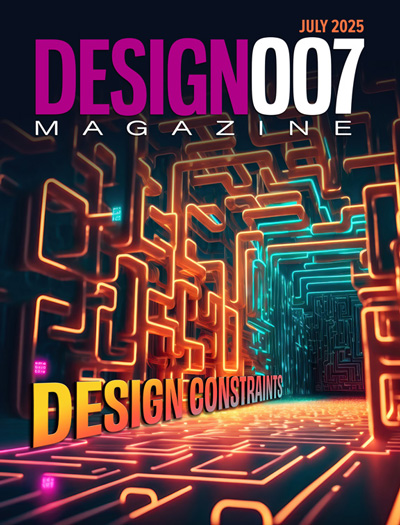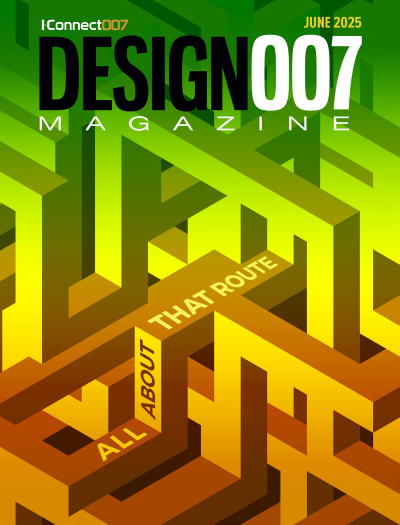-

- News
- Books
Featured Books
- design007 Magazine
Latest Issues
Current Issue
Proper Floor Planning
Floor planning decisions can make or break performance, manufacturability, and timelines. This month’s contributors weigh in with their best practices for proper floor planning and specific strategies to get it right.

Showing Some Constraint
A strong design constraint strategy carefully balances a wide range of electrical and manufacturing trade-offs. This month, we explore the key requirements, common challenges, and best practices behind building an effective constraint strategy.

All About That Route
Most designers favor manual routing, but today's interactive autorouters may be changing designers' minds by allowing users more direct control. In this issue, our expert contributors discuss a variety of manual and autorouting strategies.
- Articles
- Columns
- Links
- Media kit
||| MENU - design007 Magazine
Z-zero Launches v2019.1 of Z-Planner and Z-Solver for PCB Stackup Design
April 30, 2019 | Z-zeroEstimated reading time: 2 minutes
Z-zero has announced the third major release of its PCB stackup planning software products—Z-planner, for PCB stackup design and materials selection, and Z-solver, for quick, accurate impedance and insertion loss results.
New Features in 2019.1
Bill Hargin, Director of Everything at Z-zero, noted, “This release has a good mix of our own innovation combined with helpful requests from our growing user community. Our first two releases were tied to building the product architecture and laminate library, and the theme for this release is adding automation for stackup tasks that used to take a good bit of time.”
2019.1 adds full metric system support, enabling hardware teams to work in the units their customers and industries are most accustomed to. This is, of course, particularly important in automotive and in the European market. Z-zero takes it a step further—allowing users to choose between centimeters (cm), millimeters (mm), or microns (um) for most physical attributes.
Signal integrity engineers requested single-ended and differential coplanar waveguide support, which are supported in 2019.1. SI engineers also requested the ability for automated trace width and spacing calculations for target impedances, which is accommodated in this release, including unlimited single-ended and differential-impedance classes and functionality for meeting design requirements with target differential-pitch values.
The 2019.1 release adds the ability to import additional PCB fabricator stackup formats that were requested by hardware OEMs, as well as ANSYS SIwave and HFSS 3D Layout.
New laminate libraries are provided, including materials from AGC-Nelco, Nanya Plastics, Ventec, and updates to the TUC (Taiwan Union Corp.) product line.
Z-planner’s patent-pending automated material matching utility—new with 2019.1—allows hardware designers to match materials in existing stackup using up to six different material parameters the materials library with an option to recreate the existing stackup if desired.
Significant Benefits for Digital Hardware Engineering Teams
Most hardware designers are comfortable representing PCB stackups using spreadsheets, so Z-planner is architected to look and operate like one. The tool bridges the sizable gap between the spreadsheets many engineers and fabricators use to describe their stackups and the PCB signal-integrity world — with a super-short learning curve.
Previous releases included import/export interfaces for IPC-2581 and Mentor’s HyperLynx signal-integrity software, allowing users to bring legacy stackups into Z-planner, taking advantage of some of the additional features and functionality in Z-planner, including a 150+ material library and awareness of glass styles, resin contents, pressed prepreg thicknesses, the frequency dependence of dielectric constants (Dk) and dissipation factors (Df), and automation of the PCB stackup design process. Engineering teams that are serious about signal integrity, crosstalk, and power integrity should find Z-planner to be an accuracy-increasing addition to their high-speed design flow, all bundled into a powerful, affordably priced, easy-to-use tool.
About Z-solver
Z-zero’s Z-solver provides the most reasonably priced path to making what-if tradeoffs between Dk, Df, physical trace topologies, and spacing, with results that include single-ended impedance, differential impedance, propagation delay, loss as a function of frequency, and the effects of copper roughness.
Both Z-planner and Z-solver include the time-tested HyperLynx boundary-element 2D field solver.
About Z-zero
Z-zero, based in Redmond, Washington, develops PCB stackup planning and material-selection software for electronic system design. For further information or to download a free evaluation of the software and stackup-design tutorial, please visit www.z-zero.com.
Testimonial
"Our marketing partnership with I-Connect007 is already delivering. Just a day after our press release went live, we received a direct inquiry about our updated products!"
Rachael Temple - AlltematedSuggested Items
Trouble in Your Tank: Minimizing Small-via Defects for High-reliability PCBs
08/27/2025 | Michael Carano -- Column: Trouble in Your TankTo quote the comedian Stephen Wright, “If at first you don’t succeed, then skydiving is not for you.” That can be the battle cry when you find that only small-diameter vias are exhibiting voids. Why are small holes more prone to voids than larger vias when processed through electroless copper? There are several reasons.
The Government Circuit: Navigating New Trade Headwinds and New Partnerships
08/25/2025 | Chris Mitchell -- Column: The Government CircuitAs global trade winds continue to howl, the electronics manufacturing industry finds itself at a critical juncture. After months of warnings, the U.S. Government has implemented a broad array of tariff increases, with fresh duties hitting copper-based products, semiconductors, and imports from many nations. On the positive side, tentative trade agreements with Europe, China, Japan, and other nations are providing at least some clarity and counterbalance.
How Good Design Enables Sustainable PCBs
08/21/2025 | Gerry Partida, Summit InterconnectSustainability has become a key focus for PCB companies seeking to reduce waste, conserve energy, and optimize resources. While many discussions on sustainability center around materials or energy-efficient processes, PCB design is an often overlooked factor that lies at the heart of manufacturing. Good design practices, especially those based on established IPC standards, play a central role in enabling sustainable PCB production. By ensuring designs are manufacturable and reliable, engineers can significantly reduce the environmental impact of their products.
50% Copper Tariffs, 100% Chip Uncertainty, and a Truce
08/19/2025 | Andy Shaughnessy, I-Connect007If you’re like me, tariffs were not on your radar screen until a few months ago, but now political rhetoric has turned to presidential action. Tariffs are front-page news with major developments coming directly from the Oval Office. These are not typical times. President Donald Trump campaigned on tariff reform, and he’s now busy revamping America’s tariff policy.
Global PCB Connections: Understanding the General Fabrication Process—A Designer’s Hidden Advantage
08/14/2025 | Markus Voeltz -- Column: Global PCB ConnectionsDesigners don’t need to become fabricators, but understanding the basics of PCB fabrication can save you time, money, and frustration. The more you understand what’s happening on the shop floor, the better you’ll be able to prevent downstream issues. As you move into more advanced designs like HDI, flex circuits, stacked vias, and embedded components, this foundational knowledge becomes even more critical. Remember: the fabricator is your partner.


